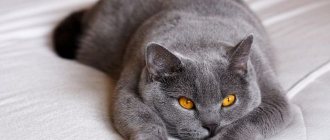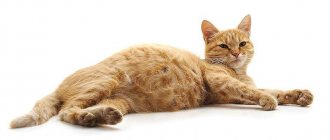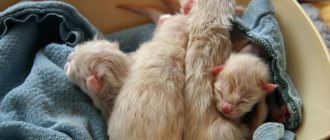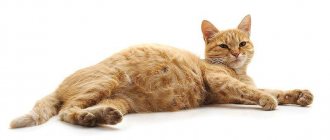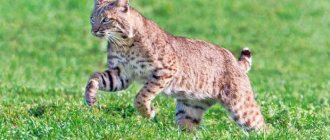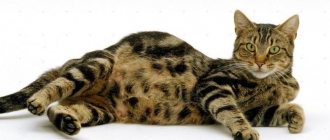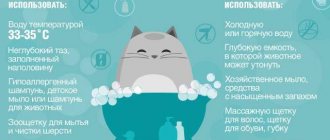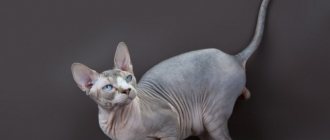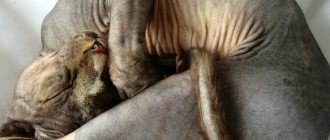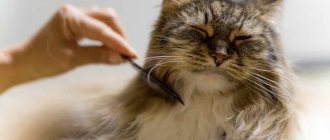In order for a pregnant Sphynx cat to be able to bear offspring normally and give birth to kittens on time, it is important not to rush into mating and wait until the animal reaches full physical maturity, which does not occur earlier than 12-14 months. Don, Canadian Sphynxes and the Peterbald variety become sexually mature at the age of 6-9 months. But early pregnancy in cats can negatively affect the health of mother and babies. Therefore, it is better to wait until the cat grows up, and only then introduce her to her gentleman.
How to recognize pregnancy?
Estrus in Sphynx cats can last throughout the year, but the animal shows the most desire, like all felines, in the spring. The first signs of sexual heat may appear at the age of 6-9 months, but at this age physical development is not yet complete, so early pregnancy in sphinxes often comes with complications; premature births often occur, in which kittens are born dead. Therefore, the optimal period for the first mating is the age of 12-14 months.
If the mating was successful, the following signs will help you understand:
- Excessive pickiness. Peterbalds, Canadian and Don cats literally change their mood literally the next day after mating. The animal requires increased attention, affection, and may refuse its usual food.
- Swollen nipples. If a female's mammary glands are swollen, this is the main sign that pregnancy has occurred.
- Toxicosis. Hairless cats are prone to intoxication, which often occurs at 3-4 weeks.
- Weight gain. At 5-6 weeks, the cat begins to gain weight, and her belly noticeably increases.
- The appearance of colostrum. A couple of weeks before giving birth, colostrum begins to appear from the cat's nipples.
Don Sphynx kittens
Sphynxes are born blind, deaf and toothless. All these features begin to disappear by two weeks after birth. At four weeks, kittens can already feed themselves and begin to crawl out of their “nest.”
Being in a cozy and warm nest, kittens feed on their mother's milk. Female Sphynx cats usually do not have problems with milk.
Owners do not have to feed the kittens.
The cat keeps the maternity nest clean all the time the Don Sphynx kittens are near their mother. The mother regularly licks and washes her offspring. It is advisable to give kittens to new owners at the age of 1.5–2 months. The kids will get stronger and become completely independent. You can come up with nicknames for kittens in advance, or you can leave this choice to new owners (especially if a pedigree is not expected).
Dates of pregnancy
In this state, the pet is more lethargic than usual.
The average duration of gestation for sphinxes is 8-9 weeks. All this time, while the hairless cat is bearing offspring, she is subject to apathy, indifference, and is reluctant to communicate with the owner and other family members. Usually, before the upcoming birth, the animal will choose some kind of box, where it will try to create a secluded corner suitable for newborn kittens.
Care and feeding
While Sphynx cats are walking in position, it is important for the owner to provide them with a balanced diet. In order for the animal to fully receive the necessary vitamins, minerals and other important components, it is better to feed it with commercial food intended for pregnant cats. If preference is given to natural food, care should be taken to ensure a balance of protein and calcium in the diet. During the entire pregnancy period, the cat should be monitored by a veterinarian who will give advice on nutrition and maintenance.
The rules for caring for the Canadian and Don breeds are no different. When the pregnancy is late, it is better not to let the cat go outside, where she can meet a cat and be re-fertilized even in pregnancy. In this case, the growth and development of other offspring will be inferior, and the expectant mother risks suffering and sometimes dying from complications. In addition, it is important to exclude stress, sudden movements, and jumping from heights from the cat’s life. To keep the skin clean, it is recommended to regularly wipe the cat’s body with a damp, soft cloth dipped in warm water.
Signs of giving birth in cats
You can predict an imminent birth by the increased sleepiness of the pet.
A Canadian or Don Sphynx may give birth a little earlier than expected, especially if the animal gives birth for the first time. You can find out that your pet is about to become a mother by the following signs:
- the appearance of white discharge on the genitals;
- lethargy, constant drowsiness;
- an increase in the size of the mammary glands and nipples;
- frequent urination;
- the desire to retire, to find a secluded closed place;
- refusal of food.
How is childbirth?
In one litter, hairless cats have 3-6 kittens. Childbirth in sphinxes often occurs without complications, but if the cat had any problems during pregnancy, it is better to invite a veterinarian who will monitor the pet’s condition throughout the entire birth process. During contractions, mucous discharge with bloody inclusions appears from the vagina. An average of 25-30 minutes passes between contractions, then the amniotic sac appears, after which kittens are born, which are born at intervals of 15-20 minutes. Newborn kittens are shrouded in a shell from which the mother must free them on her own. The cat also bites the umbilical cord itself, but if for some reason she does not do this, the owner or veterinarian needs help.
It is necessary to ensure that after each kitten the cat leaves the placenta. If this does not happen, severe inflammation develops, due to complications of which the animal may die.
Newborn offspring usually begin feeding immediately.
Newly born kittens are left near their mother. It is important to ensure that the cat and babies are warm. Immediately after giving birth, the pet often becomes calmer. It is important for the owner to ensure that each kitten finds the nipple and receives the first colostrum necessary to strengthen the immune system and ensure full further development.
When do you need help?
Sometimes it happens that a Sphynx cat walks normally throughout pregnancy, but complications occur during the birth process. In such a situation, it is necessary to help the animal cope with the problem. Help is required in the following cases:
- Weak contractions. If labor is disrupted, the doctor will advise giving a stimulating injection.
- Problems with fetal movement. Vaseline, which is used to lubricate the vagina, will help facilitate the process. Then you need to make a loop from a rag, with which you can help pull the baby out.
- The kitten has weak breathing. If the baby is weak and cannot breathe on his own, it is recommended to give him a heart massage, alternating with artificial respiration.
- The cat did not free the newborn from the bladder and did not gnaw the umbilical cord. You need to help the pet by tearing the film and cutting the umbilical cord with scissors.
- The kitten choked on amniotic fluid. You should turn the baby upside down and shake gently. A sign that all is well is the kitten sneezing, coughing and taking a deep breath.
Description of the breed
Many people spoke quite impartially about this breed, pointing out that sphinxes have no future, since they are unaesthetic animals and sensitive to cold. They argued that the breed was of purely technical interest.
At the same time, many generally considered animals to be harmful and abnormal, since they are not able to provide for themselves on their own and are completely dependent on humans.
If we talk about modern sphinxes, then their description will not be unambiguous, since even one breed may differ in some differences in the exterior, as well as in the type of hairlessness.
Appearance
Modern Sphynxes practically no longer have the main feature - folded skin, which created the appearance of cats similar to wrinkled old men. These days, these are animals that resemble smooth porcelain figurines. It should be noted that kittens do have some excess skin, but this disappears over time as they grow older, although these obvious signs can still be seen on the neck or head.
Nowadays, among the Canadian sphinxes one can still note a significant number of the most folded specimens.
According to many experts, a large proportion of modern Sphynxes are beginning to degenerate and are becoming more and more similar to the hairless Devon Rex of the usual type, with thin skin, relatively round eyes, low-set mustaches, a short head and a bone structure that is uncharacteristic of Sphynxes.
Sphynx – All about the breed
Watch this video on YouTube
Breed standards
Each breed of hairless cats has its own beauty criteria. In addition, it should be noted that within each breed several variants of the requirements for the exterior of cats can coexist. Sphynx cats, for example, are valued according to both CFA and TICA standards.
The most interesting thing is that experts are of little interest in the fact that an animal has no hair, since they pay more attention to the shape of the head, the constitution of the body, the grace of movements and the general impression created by the breed. As for the details, experts are interested in muscular limbs, with the hind legs longer than the front ones, the paws proportional, the tummy pear-shaped and, at the same time, an elegant tail, although it looks like a “rat”
As for the details, experts are interested in muscular limbs, with the hind legs being longer than the front ones, the paws being proportional, the tummy pear-shaped and, at the same time, an elegant tail, although it looks like a “rat’s”.
Skin folds are more characteristic of the head, muzzle, neck, and shoulders. If you touch the skin covered with delicate down, you feel warm suede
Any body color is taken into account, including those with white spots
A high-breed sphinx, as a rule, has a magical effect on those around it, which is due to the presence of rather smooth lines of the animal’s naked body, as well as the penetrating gaze of its unique eyes.
Character and behavior
As a rule, many are frightened by the unusual appearance of sphinxes, but those who dare to pick up this animal immediately turn into one of the lovers of these unique animals. Sphinxes are not known for their obsessive behavior, although they always prefer to be close to their owner. These animals have a peaceful and friendly character. They accept strangers as their long-time friends and easily get along with other animals in a person’s home.
In addition, sphinxes are considered intelligent, affectionate and affectionate creatures who can patiently wait for their owner if he is delayed for some reason.
These animals completely trust a person and love them if a person treats them the same way. These cats are easy to train due to their intelligence and memory. Moreover, these are strong animals that can reach a height of at least 1 meter without much effort.
Their behavior sometimes resembles that of a dog, since sphinxes are able to bring various objects to their owner. They easily open doors, as well as various cabinets, and can repeat basic tricks. Thanks to their unique appearance, as well as their natural acting talent, sphinxes are loved by filmmakers and photographers.
How long do sphinxes live?
At one time, a sphinx named Bambi set a longevity record, living for 19 years. Since then, no representatives of hairless cats have managed to break this record.
According to experts, the average life expectancy of sphinxes is just over 12 years, which is due to the consequences of breeding
In order for your pet to live as long as possible, special attention should be paid to a healthy diet, attentive care, and frequent visits to an experienced veterinarian.
Postpartum care
If there are any postpartum complications, your pet should be taken to the doctor.
If the labor function is not disturbed and no complications arose during the process, the new mother will completely get herself in order within a couple of hours. It is important for the owner to follow up. How the cat behaves, does it have anxiety or other problems. If discharge appears from the genitals over the course of a week, but it is not abundant, this is normal, otherwise it is necessary to show your pet to a doctor.
It is also important to monitor the condition of newborn kittens. Children who do not have health problems have a good appetite, good sleep, and active movements. If the kitten is lethargic, constantly meows, refuses to eat and is noticeably smaller in size than its brothers and sisters, it is better to call a veterinarian, who, after an initial examination, will determine what to do next. During feeding, the cat should have a complete, balanced diet. In addition, it is important to ensure that clean, fresh water is freely available. On the advice of a doctor, you can enrich your diet with vitamin supplements.
What does (low) multiple pregnancy depend on?
There are both a huge number of hypotheses and scientifically proven facts on this matter. Our topic is not a dissertation for an academic degree, so we will lump all theories and evidence into one common pile.
- Proper and nutritious nutrition has an important influence on conception, subsequent pregnancy and childbirth: the worse a cat eats, the less likely it is to become pregnant. There is such a thing as nutritional infertility - in this way nature tries to prevent the appearance of non-viable or sick offspring.
- The weight of the pet also plays an important role in the production of eggs and subsequent pregnancy. It is well known that obese females not only do not become pregnant, but they, in principle, do not go into estrus - what kind of multiple pregnancy can we even talk about in this case?
- Living conditions: comfort, warmth, cleanliness, lack of stress, etc.
- Hereditary factor: if a cat was born from a low-fertility mother, then the likelihood that she will also produce “a little” kittens is very high!
- A history of infectious diseases that somehow affect the development of reproductive function.
- Diseases of the reproductive system and injuries also affect the number of eggs produced.
- The temperament of a cat, no matter how strange it may sound. After all, it is well known that ovulation in cats occurs at the moment of coitus, and the sexier the male is, the more he cares for the bride, the more eggs will be released.
- Incompatibility with the opposite sex, which also occurs in humans. So, for example, there lived an allegedly infertile cat who was in heat, and they bred her with three different cats, but there was no effect. Until her permanent fiancé appeared in her living space. Apparently, the every minute presence of the cat, its smell, awakened hidden possibilities in the “woman’s” body.
- Let’s remember once again about cats, or more precisely about the quality of their sperm. The weaker the sperm, the smaller their number, the more underdeveloped among them, the less the chance of getting healthy, and most importantly, multiple offspring from a healthy cat. In turn, the quality of sperm depends on the nutrition of the reproductive system and the frequency of its use (both excessive use and abstinence have a negative impact on reproductive function).
- Low hormonal levels of the expectant mother, when the follicles produce few eggs ready for fertilization.
- Long-term use of antisex hormones will not only affect the number of offspring, but also its viability. Most often, a cat mated after such therapy brings 1-2 kittens, while they are weak or not at all capable of life outside the womb.
- Individual characteristics of the body, size, weight, age, etc., etc.
- Breed is another factor. For example, outbred cats can give birth to many kittens in the first, subsequent, and very last pregnancies. Whereas blue-blooded animals rarely bring more than 5.
- It is believed that the number of matings affects the number of kittens. Allegedly, after the first mating, the animal brings 1-2 kittens, by the seventh it reaches its natural maximum, and after that the number of offspring decreases again.
- Another theory, more like nonsense, says: the sooner insemination occurs from the start of estrus, the more kittens will be born.

